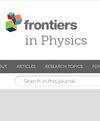A review of emerging trends in photonic deep learning accelerators
IF 1.9
3区 物理与天体物理
Q2 PHYSICS, MULTIDISCIPLINARY
引用次数: 0
Abstract
Deep learning has revolutionized many sectors of industry and daily life, but as application scale increases, performing training and inference with large models on massive datasets is increasingly unsustainable on existing hardware. Highly parallelized hardware like Graphics Processing Units (GPUs) are now widely used to improve speed over conventional Central Processing Units (CPUs). However, Complementary Metal-oxide Semiconductor (CMOS) devices suffer from fundamental limitations relying on metallic interconnects which impose inherent constraints on bandwidth, latency, and energy efficiency. Indeed, by 2026, the projected global electricity consumption of data centers fueled by CMOS chips is expected to increase by an amount equivalent to the annual usage of an additional European country. Silicon Photonics (SiPh) devices are emerging as a promising energy-efficient CMOS-compatible alternative to electronic deep learning accelerators, using light to compute as well as communicate. In this review, we examine the prospects of photonic computing as an emerging solution for acceleration in deep learning applications. We present an overview of the photonic computing landscape, then focus in detail on SiPh integrated circuit (PIC) accelerators designed for different neural network models and applications deep learning. We categorize different devices based on their use cases and operating principles to assess relative strengths, present open challenges, and identify new directions for further research.光子深度学习加速器新兴趋势综述
深度学习为工业和日常生活的许多领域带来了革命性的变化,但随着应用规模的扩大,在海量数据集上使用大型模型进行训练和推理在现有硬件上越来越难以为继。目前,图形处理器(GPU)等高度并行化的硬件已被广泛应用,以提高速度,超越传统的中央处理器(CPU)。然而,互补金属氧化物半导体(CMOS)设备受制于金属互连,在带宽、延迟和能效方面受到固有限制。事实上,预计到 2026 年,由 CMOS 芯片驱动的数据中心的全球耗电量将增加,其增幅相当于一个欧洲国家的年耗电量。硅光子(SiPh)器件正在成为电子深度学习加速器的一种有前途的高能效 CMOS 兼容替代品,它利用光来计算和通信。在这篇综述中,我们探讨了光子计算作为深度学习应用加速的新兴解决方案的前景。我们概述了光子计算的发展前景,然后详细介绍了为不同神经网络模型和深度学习应用而设计的硅光集成电路(PIC)加速器。我们根据不同设备的使用案例和工作原理对其进行分类,以评估其相对优势,提出公开挑战,并确定进一步研究的新方向。
本文章由计算机程序翻译,如有差异,请以英文原文为准。
求助全文
约1分钟内获得全文
求助全文
来源期刊

Frontiers in Physics
Mathematics-Mathematical Physics
CiteScore
4.50
自引率
6.50%
发文量
1215
审稿时长
12 weeks
期刊介绍:
Frontiers in Physics publishes rigorously peer-reviewed research across the entire field, from experimental, to computational and theoretical physics. This multidisciplinary open-access journal is at the forefront of disseminating and communicating scientific knowledge and impactful discoveries to researchers, academics, engineers and the public worldwide.
文献相关原料
| 公司名称 | 产品信息 | 采购帮参考价格 |
|---|
 求助内容:
求助内容: 应助结果提醒方式:
应助结果提醒方式:


